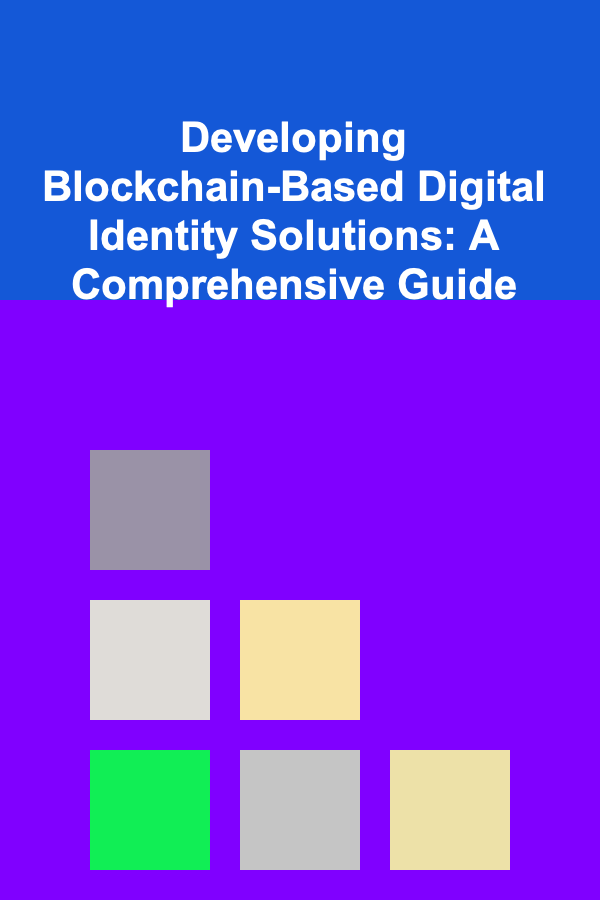
Developing Blockchain-Based Digital Identity Solutions: A Comprehensive Guide
ebook include PDF & Audio bundle (Micro Guide)
$12.99$10.99
Limited Time Offer! Order within the next:

Digital identity is becoming increasingly crucial in today's interconnected world. From online banking and healthcare to e-commerce and government services, secure and reliable identity verification is paramount. Traditional identity systems are often centralized, vulnerable to data breaches, and lack user control. Blockchain technology offers a promising alternative, enabling decentralized, secure, and user-centric digital identity solutions. This article provides a comprehensive guide to developing blockchain-based digital identity solutions, covering key concepts, architectural considerations, technical challenges, and best practices.
Understanding the Fundamentals of Blockchain and Digital Identity
What is Digital Identity?
Digital identity refers to the online representation of an individual, organization, or device. It encompasses a collection of attributes and credentials that uniquely identify an entity in the digital realm. These attributes can include personal information (name, address, date of birth), biometric data (fingerprints, facial recognition), educational qualifications, professional certifications, and online reputation.
A robust digital identity system should possess the following characteristics:
- Uniqueness: Each identity should be distinct and not shared across multiple entities.
- Verifiability: Attributes and credentials should be verifiable by relying parties.
- Security: The system should protect against unauthorized access, modification, or theft of identity information.
- Privacy: Users should have control over their identity data and consent to its use.
- Portability: Identities should be easily transferable across different systems and platforms.
- Interoperability: The system should be compatible with other identity systems and standards.
Blockchain Technology: A Foundation for Secure Digital Identity
Blockchain is a distributed, immutable, and transparent ledger technology that enables secure and verifiable transactions. Its key features include:
- Decentralization: Data is distributed across a network of nodes, eliminating a single point of failure.
- Immutability: Once a transaction is recorded on the blockchain, it cannot be altered or deleted.
- Transparency: All transactions are publicly visible on the blockchain, promoting trust and accountability. (Note: privacy-preserving blockchains are an exception, as discussed later).
- Security: Cryptographic techniques, such as hashing and digital signatures, ensure the integrity and authenticity of data.
- Consensus Mechanisms: Mechanisms like Proof-of-Work (PoW) or Proof-of-Stake (PoS) ensure agreement among nodes on the validity of transactions.
Blockchain can be leveraged to create digital identity solutions that address the shortcomings of traditional centralized systems. By storing identity attributes on a blockchain, users can maintain control over their data and selectively share it with relying parties. The immutability and transparency of the blockchain ensure the integrity and verifiability of identity information.
Architecture of a Blockchain-Based Digital Identity System
A blockchain-based digital identity system typically consists of the following components:
- User Wallet: A digital wallet or application that allows users to manage their identity attributes, credentials, and keys. This wallet is crucial for interacting with the blockchain and controlling access to their identity data.
- Blockchain Ledger: The distributed ledger that stores identity information and transaction records. This could be a public, private, or permissioned blockchain, depending on the specific requirements.
- Identity Providers (IdPs): Trusted entities that verify and attest to the accuracy of identity attributes. IdPs can include government agencies, educational institutions, and financial institutions.
- Verifiers/Relying Parties (RPs): Entities that require identity verification to provide services or grant access. Examples include online retailers, healthcare providers, and government agencies.
- Smart Contracts: Self-executing contracts stored on the blockchain that automate identity verification processes and enforce access control policies.
The interaction between these components typically follows these steps:
- Identity Registration: A user registers with one or more Identity Providers (IdPs). The IdP verifies the user's identity and issues a digital credential (e.g., a digitally signed attestation) containing validated attributes.
- Attribute Storage: The user stores their digital credential (or a hash of it) in their user wallet, linked to their blockchain identity. The user retains control over this data.
- Verification Request: A Verifier/Relying Party (RP) requests verification of specific identity attributes from the user.
- Selective Disclosure: The user, using their wallet, selectively discloses the requested attributes to the RP. They may prove ownership of the attributes without revealing the actual data (e.g., using Zero-Knowledge Proofs).
- Verification Process: The RP verifies the authenticity and validity of the disclosed attributes. This may involve checking the IdP's signature on the digital credential, querying the blockchain for relevant information, or running a smart contract to enforce access control policies.
- Access Granted: If the verification is successful, the RP grants the user access to the requested service or resource.
Types of Blockchains for Digital Identity
The choice of blockchain platform is a critical decision when developing a digital identity solution. The three main types of blockchains are:
- Public Blockchains: Open and permissionless blockchains, such as Bitcoin and Ethereum, where anyone can participate in the network and validate transactions. While offering high levels of decentralization and transparency, public blockchains may not be suitable for storing sensitive identity information due to their public nature and potential scalability limitations.
- Private Blockchains: Closed and permissioned blockchains, where access is restricted to a specific group of participants. Private blockchains offer greater control over data privacy and scalability but sacrifice decentralization. They are typically used in enterprise settings where trust is established between participants.
- Permissioned (Consortium) Blockchains: Hybrid blockchains that offer a balance between decentralization and control. Access is restricted to a consortium of organizations, allowing for greater collaboration and trust. Examples include Hyperledger Fabric and Corda. These are often a good choice for digital identity systems involving multiple organizations.
The selection of the appropriate blockchain type depends on the specific requirements of the digital identity solution, including data privacy, scalability, regulatory compliance, and trust model.
Technical Challenges and Solutions
Developing blockchain-based digital identity solutions presents several technical challenges that need to be addressed:
Scalability
Blockchains typically have limited transaction throughput compared to centralized databases. This can be a bottleneck for digital identity solutions that require high transaction volumes, such as large-scale user registration and verification. Consider these strategies to address scalability:
- Layer-2 Solutions: Implement layer-2 scaling solutions, such as state channels and sidechains, to offload transactions from the main blockchain.
- Sharding: Divide the blockchain into multiple shards, each processing a subset of transactions concurrently.
- Consensus Algorithm Optimization: Employ more efficient consensus algorithms, such as Delegated Proof-of-Stake (DPoS) or Practical Byzantine Fault Tolerance (PBFT), to improve transaction throughput.
Data Privacy
Storing sensitive identity information on a public blockchain can raise privacy concerns. Encryption alone is not always sufficient because the metadata surrounding transactions can still reveal information. Consider these privacy-enhancing technologies (PETs):
- Zero-Knowledge Proofs (ZKPs): Allow users to prove the validity of identity attributes without revealing the underlying data. For example, a user can prove they are over 18 without revealing their birthdate.
- Homomorphic Encryption: Enables computations to be performed on encrypted data without decrypting it.
- Selective Disclosure Credentials (SDCs): Allow users to selectively disclose only the necessary attributes to relying parties.
- Off-Chain Storage: Store sensitive identity information off-chain in secure, encrypted databases, and only store hashes or cryptographic commitments on the blockchain.
Interoperability
Digital identity solutions should be interoperable with other systems and platforms to enable seamless integration and data exchange. This is particularly important for creating a truly portable and reusable digital identity.
- Standardization: Adhere to industry standards and protocols, such as the W3C Verifiable Credentials standard and the Decentralized Identifiers (DIDs) specification.
- Cross-Chain Communication: Implement cross-chain communication protocols to enable interoperability between different blockchains.
- APIs and SDKs: Provide well-defined APIs and SDKs to facilitate integration with existing systems.
Key Management
Secure key management is crucial for protecting user identities and preventing unauthorized access. Users must be able to securely generate, store, and manage their private keys.
- Hardware Security Modules (HSMs): Use HSMs to securely store and manage private keys.
- Multi-Party Computation (MPC): Distribute private keys across multiple parties to prevent single points of failure.
- Threshold Signatures: Require multiple parties to sign a transaction to authorize it.
- Key Recovery Mechanisms: Implement secure key recovery mechanisms to help users regain access to their identities if they lose their private keys. However, this needs to be carefully balanced with security and user control. Options include social recovery or trusted third-party recovery services.
Regulatory Compliance
Digital identity solutions must comply with relevant regulations and laws, such as GDPR, CCPA, and KYC/AML requirements. Consider these points:
- Data Minimization: Collect only the necessary identity attributes and retain them for the minimum required time.
- User Consent: Obtain explicit user consent before collecting, processing, or sharing identity data.
- Data Security: Implement appropriate security measures to protect identity data from unauthorized access, modification, or disclosure.
- Auditability: Maintain audit logs to track access to identity data and ensure compliance with regulations.
Development Best Practices
Following best practices during development is essential for creating robust, secure, and user-friendly blockchain-based digital identity solutions:
- Start with a Clear Use Case: Define the specific problem you are trying to solve and the target audience for your solution. This will help guide your design and development efforts.
- Choose the Right Blockchain Platform: Select the blockchain platform that best suits your requirements, considering factors such as data privacy, scalability, and regulatory compliance.
- Prioritize Security: Implement robust security measures to protect user identities and prevent unauthorized access. Conduct thorough security audits and penetration testing.
- Design for Usability: Create a user-friendly interface that is easy to navigate and understand. Provide clear instructions and guidance to users.
- Embrace Standardization: Adhere to industry standards and protocols to ensure interoperability and portability.
- Iterative Development: Adopt an iterative development approach, releasing early and often to gather user feedback and refine your solution.
- Consider the Legal and Ethical Implications: Carefully consider the legal and ethical implications of your solution, particularly regarding data privacy and user rights. Engage with legal and ethical experts to ensure compliance and responsible innovation.
Real-World Examples and Use Cases
Blockchain-based digital identity solutions are being explored and implemented in various industries:
- Healthcare: Patients can securely manage their medical records and selectively share them with healthcare providers.
- Finance: Streamline KYC/AML processes and prevent fraud by providing a verifiable digital identity for customers.
- Government: Issue digital IDs and passports, enabling secure and efficient access to government services.
- Education: Issue and verify academic credentials, preventing fraud and streamlining the hiring process.
- Supply Chain: Track and trace products throughout the supply chain, ensuring authenticity and preventing counterfeiting.
For instance, Estonia's digital identity program, while not fully blockchain-based, showcases the benefits of a secure and convenient digital identity system. Similarly, initiatives are underway to explore blockchain-based solutions for refugee identity management, addressing a critical need for displaced populations.
Future Trends and Opportunities
The field of blockchain-based digital identity is rapidly evolving, with several emerging trends and opportunities:
- Self-Sovereign Identity (SSI): SSI empowers individuals to own and control their digital identities, giving them greater autonomy and privacy. This is a core principle driving many blockchain identity initiatives.
- Decentralized Identifiers (DIDs): DIDs are globally unique identifiers that enable individuals to control their digital identities without relying on centralized authorities.
- Verifiable Credentials (VCs): VCs are digitally signed attestations that can be used to verify identity attributes.
- Integration with IoT Devices: Extending digital identities to IoT devices to enable secure and verifiable device authentication and authorization.
- Advanced Privacy-Preserving Technologies: Continued advancements in zero-knowledge proofs, homomorphic encryption, and other privacy-enhancing technologies will further enhance the privacy and security of digital identity solutions.
- Metaverse Identities: As the metaverse evolves, secure and portable digital identities will be crucial for enabling seamless interactions and transactions across different virtual worlds.
Conclusion
Blockchain technology offers a powerful foundation for building secure, decentralized, and user-centric digital identity solutions. By addressing the technical challenges and following best practices, developers can create innovative solutions that empower individuals to control their identities and participate more securely in the digital world. While challenges remain regarding scalability, privacy, interoperability, and regulatory compliance, the potential benefits of blockchain-based digital identity are significant. As the technology matures and adoption increases, we can expect to see more widespread use of these solutions across various industries and applications.
The key to successful implementation lies in careful planning, a strong understanding of the technology, and a commitment to user privacy and security. As the digital world continues to evolve, blockchain-based digital identity solutions will play an increasingly important role in shaping the future of online interactions and transactions.

How to Create Easy-to-Follow Craft Project Kits
Read More
How to Master Frugal Living with Kids
Read MoreMarketing Tips for Selling Digital Health Trackers
Read More
How to Understand the Adaptations of Intertidal Organisms
Read More
How to Dispute Errors on Your Credit Report Related to Cards
Read More
How to Use an Event Planning Checklist for Virtual Conferences
Read MoreOther Products

How to Create Easy-to-Follow Craft Project Kits
Read More
How to Master Frugal Living with Kids
Read MoreMarketing Tips for Selling Digital Health Trackers
Read More
How to Understand the Adaptations of Intertidal Organisms
Read More
How to Dispute Errors on Your Credit Report Related to Cards
Read More